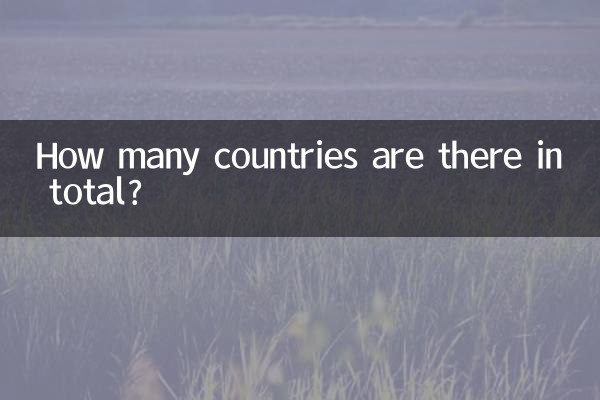How many countries are there in total?
In today's world of globalization, knowing how many countries there are in the world is a common question. However, the answer to this question is not as simple as it seems. The number of countries will vary based on different standards and international recognition. The following is a detailed analysis of the number of countries around the world, as well as hot topics and hot content in the past 10 days.
Global country statistics

Currently, the most widely recognized number of countries comes from United Nations membership. As of 2024, the United Nations has 193 member states and 2 observer states (Vatican and Palestine). The following is a detailed data table:
| category | quantity | illustrate |
|---|---|---|
| United Nations Member States | 193 | A sovereign country widely recognized by the international community |
| United Nations observer state | 2 | Vatican and Palestine |
| Partially recognized countries | 10-15 | Such as Kosovo, Taiwan, etc. |
| unrecognized country | 5-10 | Such as Somaliland, Northern Cyprus, etc. |
Hot topics in the past 10 days
The following are hot topics and hot content that have caused widespread discussion around the world in the past 10 days:
| topic | heat index | Main discussion content |
|---|---|---|
| Preparations for the 2024 Olympic Games | ★★★★★ | Preparatory progress for the Paris Olympics and the dynamics of athletes from various countries |
| global climate change | ★★★★☆ | Frequent occurrence of extreme weather events, various countries’ response measures |
| Artificial intelligence development | ★★★★☆ | The latest breakthroughs and application scenarios of AI technology |
| international political situation | ★★★☆☆ | Trends in hotspot areas such as the Russia-Ukraine conflict and the situation in the Middle East |
| global economic trends | ★★★☆☆ | Inflation, monetary policy and trade relations |
Reasons for the dispute over the number of countries
There is controversy about how many countries there are in the world, mainly for the following reasons:
1.International recognition issues:Some regions have declared independence but have not received widespread international recognition, such as Kosovo and Taiwan.
2.Sovereignty disputes:There are sovereignty disputes in some areas, such as Crimea and Western Sahara.
3.Autonomous regions:There is controversy over whether some highly autonomous regions are considered independent states.
4.Membership of international organizations:Different international organizations have different qualification requirements for member states.
How to correctly view the number of countries
For ordinary people, the most important thing to know about how many countries there are in the world is to clearly define the standards used:
-Academic research:The number of United Nations member states (193) is generally used as the benchmark.
-International Relations:Consideration needs to be given to areas of physical control and recognition.
-Travel planning:You may want to look into visa policies, including some that are de facto independent.
Regardless of which criterion is adopted, it is important to understand the political, historical and practical factors behind the number of countries, rather than simply pursuing a definite number.
Summarize
There is no simple answer to the question of how many countries there are in the world. According to the most widely accepted United Nations standards, there are 193 member states and 2 observer states. But taking into account partially recognized and unrecognized countries, the total number may be around 200. At the same time, recent hot topics show that the focus of the international community is on sports events, climate change, technological development and geopolitics.
Understanding the complexity of the number of countries helps us better understand international relations and the global political landscape. In the era of information explosion, it is particularly important to maintain open and dialectical thinking.

check the details

check the details